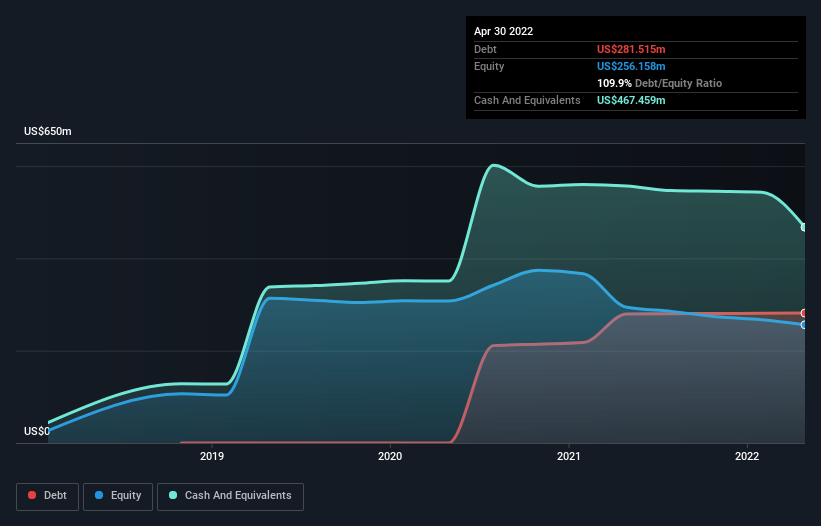
Legendary fund manager Li Lu (who Charlie Munger backed) once said, 'The biggest investment risk is not the volatility of prices, but whether you will suffer a permanent loss of capital.' So it seems the smart money knows that debt - which is usually involved in bankruptcies - is a very important factor, when you assess how risky a company is. We can see that PagerDuty, Inc. (NYSE:PD) does use debt in its business. But the real question is whether this debt is making the company risky.
When Is Debt Dangerous?
Debt assists a business until the business has trouble paying it off, either with new capital or with free cash flow. In the worst case scenario, a company can go bankrupt if it cannot pay its creditors. However, a more common (but still painful) scenario is that it has to raise new equity capital at a low price, thus permanently diluting shareholders. By replacing dilution, though, debt can be an extremely good tool for businesses that need capital to invest in growth at high rates of return. When we think about a company's use of debt, we first look at cash and debt together.
See our latest analysis for PagerDuty
What Is PagerDuty's Net Debt?
As you can see below, PagerDuty had US$281.5m of debt, at April 2022, which is about the same as the year before. You can click the chart for greater detail. However, its balance sheet shows it holds US$467.5m in cash, so it actually has US$185.9m net cash.

How Strong Is PagerDuty's Balance Sheet?
Zooming in on the latest balance sheet data, we can see that PagerDuty had liabilities of US$219.9m due within 12 months and liabilities of US$308.6m due beyond that. Offsetting these obligations, it had cash of US$467.5m as well as receivables valued at US$60.1m due within 12 months. So these liquid assets roughly match the total liabilities.
This state of affairs indicates that PagerDuty's balance sheet looks quite solid, as its total liabilities are just about equal to its liquid assets. So it's very unlikely that the US$2.23b company is short on cash, but still worth keeping an eye on the balance sheet. While it does have liabilities worth noting, PagerDuty also has more cash than debt, so we're pretty confident it can manage its debt safely. There's no doubt that we learn most about debt from the balance sheet. But ultimately the future profitability of the business will decide if PagerDuty can strengthen its balance sheet over time. So if you want to see what the professionals think, you might find this free report on analyst profit forecasts to be interesting.
In the last year PagerDuty wasn't profitable at an EBIT level, but managed to grow its revenue by 33%, to US$303m. Shareholders probably have their fingers crossed that it can grow its way to profits.
So How Risky Is PagerDuty?
Statistically speaking companies that lose money are riskier than those that make money. And in the last year PagerDuty had an earnings before interest and tax (EBIT) loss, truth be told. And over the same period it saw negative free cash outflow of US$18m and booked a US$118m accounting loss. With only US$185.9m on the balance sheet, it would appear that its going to need to raise capital again soon. With very solid revenue growth in the last year, PagerDuty may be on a path to profitability. Pre-profit companies are often risky, but they can also offer great rewards. When analysing debt levels, the balance sheet is the obvious place to start. However, not all investment risk resides within the balance sheet - far from it. To that end, you should be aware of the 3 warning signs we've spotted with PagerDuty .
If you're interested in investing in businesses that can grow profits without the burden of debt, then check out this free list of growing businesses that have net cash on the balance sheet.
If you're looking to trade PagerDuty, open an account with the lowest-cost platform trusted by professionals, Interactive Brokers.
With clients in over 200 countries and territories, and access to 160 markets, IBKR lets you trade stocks, options, futures, forex, bonds and funds from a single integrated account.
Enjoy no hidden fees, no account minimums, and FX conversion rates as low as 0.03%, far better than what most brokers offer.
Sponsored ContentNew: Manage All Your Stock Portfolios in One Place
We've created the ultimate portfolio companion for stock investors, and it's free.
• Connect an unlimited number of Portfolios and see your total in one currency
• Be alerted to new Warning Signs or Risks via email or mobile
• Track the Fair Value of your stocks
Have feedback on this article? Concerned about the content? Get in touch with us directly. Alternatively, email editorial-team (at) simplywallst.com.
This article by Simply Wall St is general in nature. We provide commentary based on historical data and analyst forecasts only using an unbiased methodology and our articles are not intended to be financial advice. It does not constitute a recommendation to buy or sell any stock, and does not take account of your objectives, or your financial situation. We aim to bring you long-term focused analysis driven by fundamental data. Note that our analysis may not factor in the latest price-sensitive company announcements or qualitative material. Simply Wall St has no position in any stocks mentioned.
About NYSE:PD
PagerDuty
Engages in the operation of a digital operations management platform in the United States and internationally.
Undervalued with excellent balance sheet.
Similar Companies
Market Insights
Community Narratives



